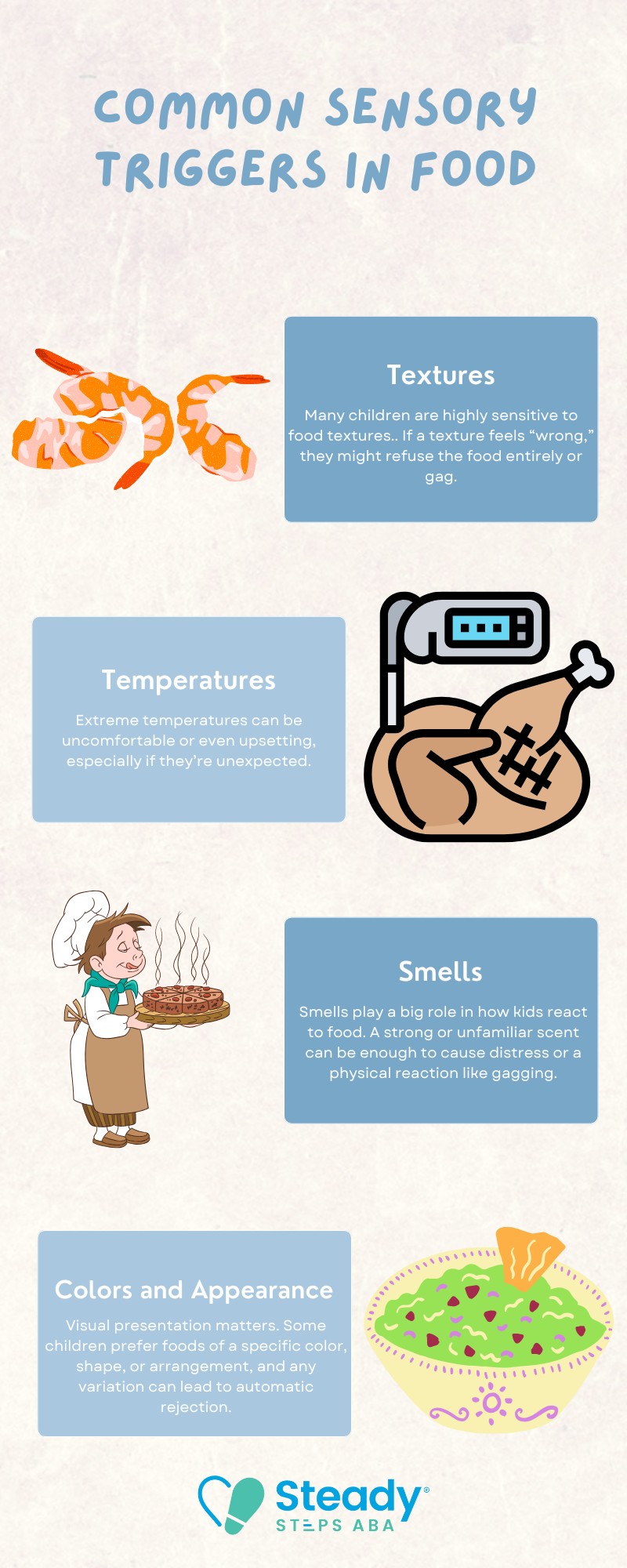Key Points:
- Food aversions in autism often stem from sensory sensitivities rather than behavioral stubbornness.
- Understanding the root causes of these aversions helps parents reduce mealtime stress and promote dietary variety.
- Structured strategies, including ABA therapy, can be used to expand food acceptance gradually and respectfully.
Research indicates that up to 80% of autistic children experience feeding difficulties, including aversions to certain foods. Food aversions in autism refer to strong, persistent avoidance of specific foods due to sensory sensitivities rather than typical pickiness.
These aversions are often tied to how the child experiences textures, smells, temperatures, or even colors of food, making mealtime a real challenge for families. For many parents, food aversions in autism aren’t just about preferences—they’re rooted in neurological and sensory processing differences.
Children with autism may gag, cry, or outright refuse to eat certain foods, not out of willful defiance but because their brain interprets the experience as overwhelming or even painful. In this article, we’ll discuss what food aversion in autism is, how it manifests in different individuals, and offer some treatment options to help.
Understanding Why Food Aversions are Common in Autism
Autistic individuals process sensory information differently. A smell that seems mild to most can be overpowering to them. A soft texture might feel slimy or unbearable. Because food is such a sensory-rich experience—taste, texture, smell, sight—it becomes a frequent source of discomfort.
The two main drivers that contribute to food aversions in autism include:
- Sensory sensitivities: Oversensitivity to texture, taste, smell, temperature, or visual appearance.
- Routine-based thinking: Many children with autism thrive on repetition. New or unexpected foods disrupt that pattern, triggering anxiety or resistance.
These aren’t behavioral issues in the traditional sense; they’re often coping mechanisms in response to overwhelming stimuli.
How Sensory Issues Affect Dietary Habits
Sensory processing challenges can make mealtime feel like a battlefield. Each bite involves multiple layers of sensory input, and if even one of those feels “wrong,” it can lead to refusal or distress. Children might avoid entire food groups not because they dislike the taste but because something about the experience feels off.
Common sensory triggers include:

These aversions can lead to highly selective eating habits—sometimes called “food jags”—where a child will only eat a narrow set of foods, often lacking variety and nutrition.
5 Most Common Food Aversions in Children With Autism
While every child is unique, certain foods tend to be more frequently rejected due to their sensory properties. Identifying patterns can help caregivers predict and navigate aversions more successfully.
Foods frequently avoided by children with autism include:
1. Mixed Textures
Foods that combine different textures—like soft, chewy, and crunchy all in one bite—can be overwhelming. This unpredictability can make meals feel chaotic or unpleasant to sensitive eaters.
2. Strong Smells or Flavors
Foods with bold aromas or intense flavors can be a major turn-off. Even the smell alone might cause gagging or refusal before a child even tastes the food.
3. Sticky or Mushy Textures
Many kids are sensitive to sticky or mushy textures that feel “slimy” or hard to swallow. These sensations can be uncomfortable or trigger a strong aversive reaction.
4. Unpredictable Consistencies
Foods that vary in texture, like seedy fruits or vegetables that cook inconsistently, can feel unpredictable and unpleasant. This variability can lead to mistrust of those foods altogether.
5. Bright or Unnatural Colors
Foods with overly bright or unnatural colors may be visually unappealing or seem suspicious to some children. Inconsistent or artificial appearances can make a food feel “unsafe” or unfamiliar.
On the flip side, some children develop strong attachments to ‘safe’ foods—often processed items that are consistent in taste and texture, like crackers, chicken nuggets, or plain pasta. For healthier alternatives that still offer comfort and familiarity, check out our article Discover 8 Comfort Foods for Autism That Support Well-being.
What Parents Can Do to Help Kids Overcome Food Aversions
Supporting a child through food aversions requires empathy, patience, and a strategy. Forcing new foods can backfire and create long-term negative associations. Instead, gradual and consistent exposure tends to work best, especially when tailored to the child’s unique sensory needs.
Strategies to support children with food aversions include:
1. Start with Preferred Textures
Begin by offering new foods that match the texture of ones your child already accepts, like crunchy carrots if they like crackers. This helps build trust and lowers the chances of rejection.
2. Use Food Chaining
Make gradual changes from a favorite food, such as switching the brand, shape, or flavor, to gently expand variety. Chaining is a step-by-step method feels safe and manageable for picky eaters.
3. Offer Consistent Exposure
Repeated, low-pressure exposure to new foods helps build familiarity over time. Even just seeing or smelling the food can be a step toward eventual acceptance.
4. Deconstruct Meals
Serve complex dishes in separate parts—like pasta, sauce, and vegetables on their own plates—to reduce sensory overwhelm. This lets kids explore each component at their own pace.
5. Involve the Child in Preparation
Having your child help with washing, chopping, or stirring allows them to explore food without pressure to eat it. Touching and smelling during prep builds comfort and curiosity.
6. Use Visual Supports
Visual meal schedules and food charts give your child a clear picture of what to expect. These tools add structure and can ease anxiety around mealtime.
7. Model Flexible Eating
Let your child watch you try and enjoy a variety of foods without pressure or fuss. Seeing trusted adults eat with openness can slowly encourage them to do the same.
Behavioral support, including ABA therapy, can guide families through structured food desensitization programs that respect the child’s boundaries.
When Should You Seek Professional Help for Feeding Issues
While some pickiness is typical in all children, persistent and severe food aversions in autism can lead to nutritional deficiencies, poor growth, and high family stress. If your child refuses various food groups or has fewer than 10 accepted foods, it could be time to consult professionals.
You should consider professional support when:
- Your child has strong reactions (e.g., gagging, vomiting, meltdowns) to new foods.
- Mealtime is a major source of daily conflict or anxiety.
- Your child’s growth, weight, or energy levels are affected.
- Your family is experiencing stress due to food limitations.
Multidisciplinary teams—including occupational therapists, speech therapists, and ABA professionals—can help assess the root of the aversion and build a step-by-step plan to improve flexibility and nutrition.
Can ABA Therapy Help With Food Aversions?
Yes, Applied Behavior Analysis (ABA) therapy can be a powerful tool in addressing food aversions in autism. ABA doesn’t just focus on behavior modification—it also helps uncover the “why” behind a behavior, including sensory or emotional triggers.
ABA therapists use data-driven techniques to increase tolerance to non-preferred foods while reinforcing positive behaviors during meals. The process is gradual and respectful, aiming to reduce stress for both the child and the caregiver.
ABA strategies used to manage food aversions include:
1. Desensitization Protocols
This approach uses gentle, step-by-step exposure to help a child get used to new foods without pressure to eat them right away. Over time, repeated exposure builds familiarity and reduces fear or aversion.
2. Positive Reinforcement
Offering praise, stickers, or other small rewards encourages positive mealtime behaviors. Reinforcement helps make food experiences feel safe, motivating, and worth trying again.
3. Task Analysis
Breaking the eating process into small, manageable steps—like touching the food, bringing it to the lips, or taking one bite—can make trying new foods feel less overwhelming. This approach supports steady, confidence-building progress.
4. Data Tracking
Keeping notes on what works, what doesn’t, and how your child responds helps fine-tune strategies. Regular tracking allows for thoughtful adjustments and highlights every small success along the way.
Rather than force-feeding or bribes, ABA uses consistent routines and supports to promote a better relationship with food over time.
5 Ways Parents Can Reduce Mealtime Stress for Their Children
Changing mealtime dynamics starts with lowering the pressure. Children with autism often pick up on tension, which can make aversions worse. Creating a calm, predictable environment sets the stage for small wins.
Ways to reduce mealtime stress include:
1. Establish a Routine
Consistent meal and snack times help create a predictable environment that feels safe and structured. When kids know what to expect, they’re more likely to approach eating with comfort and openness.
2. Minimize Distractions
Turning off screens and creating a calm, focused space makes mealtimes less overwhelming. A quiet environment helps children stay regulated and more aware of their food.
3. Use Calm Language
Instead of pressuring with phrases like “Just try it,” describe the food’s color, smell, or texture in a curious, low-pressure way. This keeps the experience positive and supports gentle exploration.
4. Set Realistic Goals
Progress looks different for every child—sometimes just allowing a new food on the plate is a win. Celebrating these small steps builds confidence and keeps momentum going.
5. Celebrate Progress
Every bit of progress, whether it’s smelling, licking, or even just tolerating a new food nearby, is worth acknowledging. Positive reinforcement helps create a more encouraging and rewarding mealtime experience.
By making meals a low-pressure opportunity for exposure instead of a battleground, children are more likely to expand their food comfort zone over time.
Help Your Child Thrive with ABA Therapy Today
If your child is struggling with mealtime, food refusal, or sensory-based aversions, Steady Steps ABA is here to support you. We offer ABA therapy in Maryland, using proven techniques to help children with autism increase their flexibility around food, manage sensory sensitivities, and build positive routines.
Food aversions in autism don’t have to dominate your family’s daily life. With structured behavioral strategies, patience, and professional guidance, meaningful progress is possible—one small step at a time.
Contact us today to learn more about how our ABA therapy in Maryland can help your child make mealtime a more enjoyable and nourishing experience.






